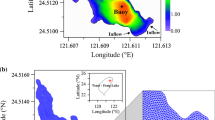Abstract
Numerical simulation of sediment transport and bed evolution has become an important technique in the sediment research. In this article, a numerical model of suspended sediment transport was proposed, which was established in the vertical σ coordinate for fitting the free surface and bottom. In the research of the sediment transport, the predominant factors were found to be the eddy diffusion, the settling velocity, the bed condition and so on. By the aid of the model in the article, the contribution of the Rouse parameter to the vertical profile of sediment concentration was clarified, which was identical to the theoretical results. In the comparison of the numerical results with laboratory data, the agreement between experimental data and numerical results was reached except for some data. And the possible reasons for the disagreement were discussed.
Similar content being viewed by others
References
QIAN Ning, WAN Zhao-hui. Sediment dynamics[M]. Beijing: Science Press, 1983(in Chinese).
NIELSEN P. Shear stress and sediment transport calculations for swash zone modeling[J]. Coastal Engineering, 2002, 45(1): 53–60.
DOU Guo-ren. Incipient motion of coarse and fine sediment[J]. Journal of Sediment Research, 1999, (6): 1–9(in Chinese).
SECHET P., GUENNEC L. The role of near wall turbulence on sediment transport[J]. Water Research, 1999, 33(17): 3646–3656.
CAO Wen-hong, ZHANG Qi-shun. A study on suspended sediment carrying capacity in combined actions of waves and tidal current[J]. Journal of Sediment Research, 2000, (5): 16–21(in Chinese).
NI Jin-ren, LIANG Lin. Particle suspension in sediment-laden flow (I) [J]. Journal of Sediment Research, 2000, (1): 7–12(in Chinese).
NI Jin-ren, LIANG Lin. Particle suspension in sediment-laden flow (II) [J]. Journal of Sediment Research, 2000, (1): 13–19(in Chinese).
ELFRINK B., BALDOCK T. Hydrodynamics and sediment transport in the swash zone: a review and perspectives[J]. Coastal Engineering, 2002, 45(3): 149–167.
ANGELIS E. D., CASCIOLA C. M., PIVA R. DNS of wall turbulence: dilute polymers and self-sustaining mechanisms[J]. Computers and Fluids, 2002, 31(4): 495–507.
DOU Guo-ren, DONG Feng-wu, DOU Xi-ping. Sediment numerical model in estuary and coastal[J]. Science in China, Ser. A, 1995, 25(9): 995–1001(in Chinese).
DOU Guo-ren, DONG Feng-wu. Sediment-carrying capacity by tidal and wave[J]. Chinese Science Bulletin, 1995, 40(5): 443–446(in Chinese).
NICHOLSON J. et al. Intercomparison of coastal area morphodynamic modes[J]. Coastal Engineering, 1997, 31(1): 97–123.
LIU Hua, ZHANG Dong-liang, He You-sheng. A 2-D vertical mathematical model for the morphological processes of a trench[J]. Journal of Hydrodynamics, Ser. B, 1999, 11(2): 56–62.
HARRIS C. K., WIBERG P. L. A two-dimensional, time-dependent model of suspended sediment transport and bed reworking for continental shelves[J]. Computers and Geosciences, 2001, 27(6): 675–690.
DAVIES A. G., Van RIJN L. C. Intercomparison of research and practical sand transport models[J]. Coastal Engineering, 2002, 46(1): 1–23.
ZHANG Jing-xin, LIU Hua, XUE Lei-ping. A vertical 2-D mathematical model for hydrodynamic flows with free surface in σcoordinate[J]. Journal of Hydrodynamics, Ser. B, 2006, 18(1): 82–90.
LUECK R. G., LU Y. Y. The logarithmic layer in a tidal channel[J]. Continental Shelf Research, 1997, 17(14): 1785–1801.
GUO Qing-chao. Numerical modeling of suspended sediment transport[D]. Ph. D. Thesis, Regina, Canada, University of Regina, 2000.
Van RIJN L C. Mathematical modeling of suspended sediment in nonuniform flows[J]. Journal of Hydraulic Engineering, Asce, 1986, 112(6): 433–455.
ZHAO Ming-deng., LI Yi-tian. Study on two-dimensional sediment mathematical models and problems in application[J]. Journal of Sediment Research, 2002, (1): 66–77(in Chinese).
YANG S. Q., TAN S K., LIM S. Y. Velocity distribution and Dipphenomenon in smooth uniform open channel flows[J]. Journal of Hydraulic Engineering, 2004, 130(12): 1179–1186.
S. Q., LIM S. Y., MCCOROUODALE J. A. Investigation of near wall velocity in 3-D smooth channel flows[J]. Journal of Hydraulic Research, Int. Association of Hydraulic Engineering and Research, 2005, 43 (2):149–157.
Author information
Authors and Affiliations
Corresponding author
Additional information
Biography: ZHANG Jing-xin (1975-),Male, Ph. D., Lecturer
Rights and permissions
About this article
Cite this article
Zhang, Jx., Liu, H. A Vertical 2-D Numerical Simulation of Suspended Sediment Transport. J Hydrodyn 19, 217–224 (2007). https://doi.org/10.1016/S1001-6058(07)60051-1
Received:
Revised:
Published:
Issue Date:
DOI: https://doi.org/10.1016/S1001-6058(07)60051-1




